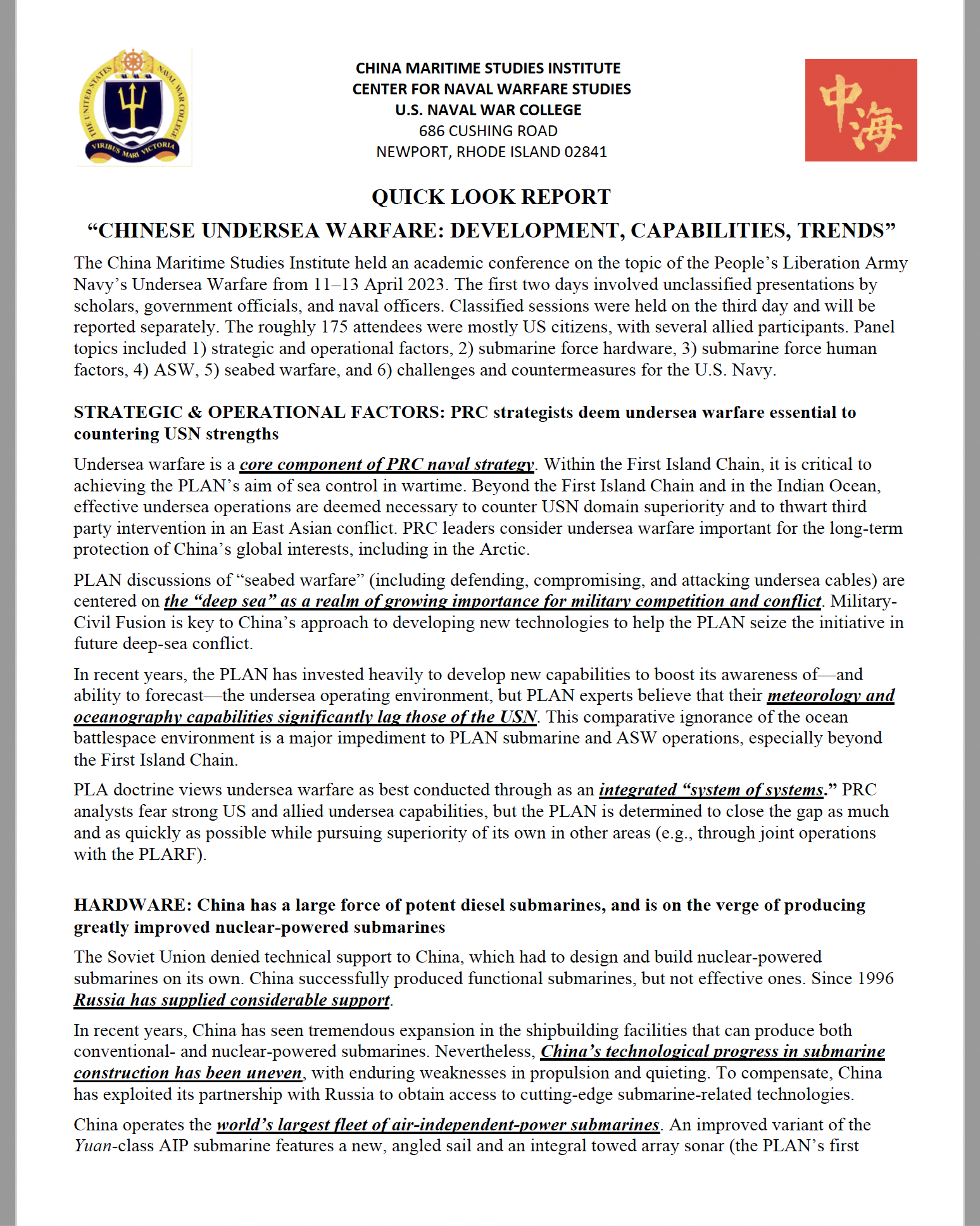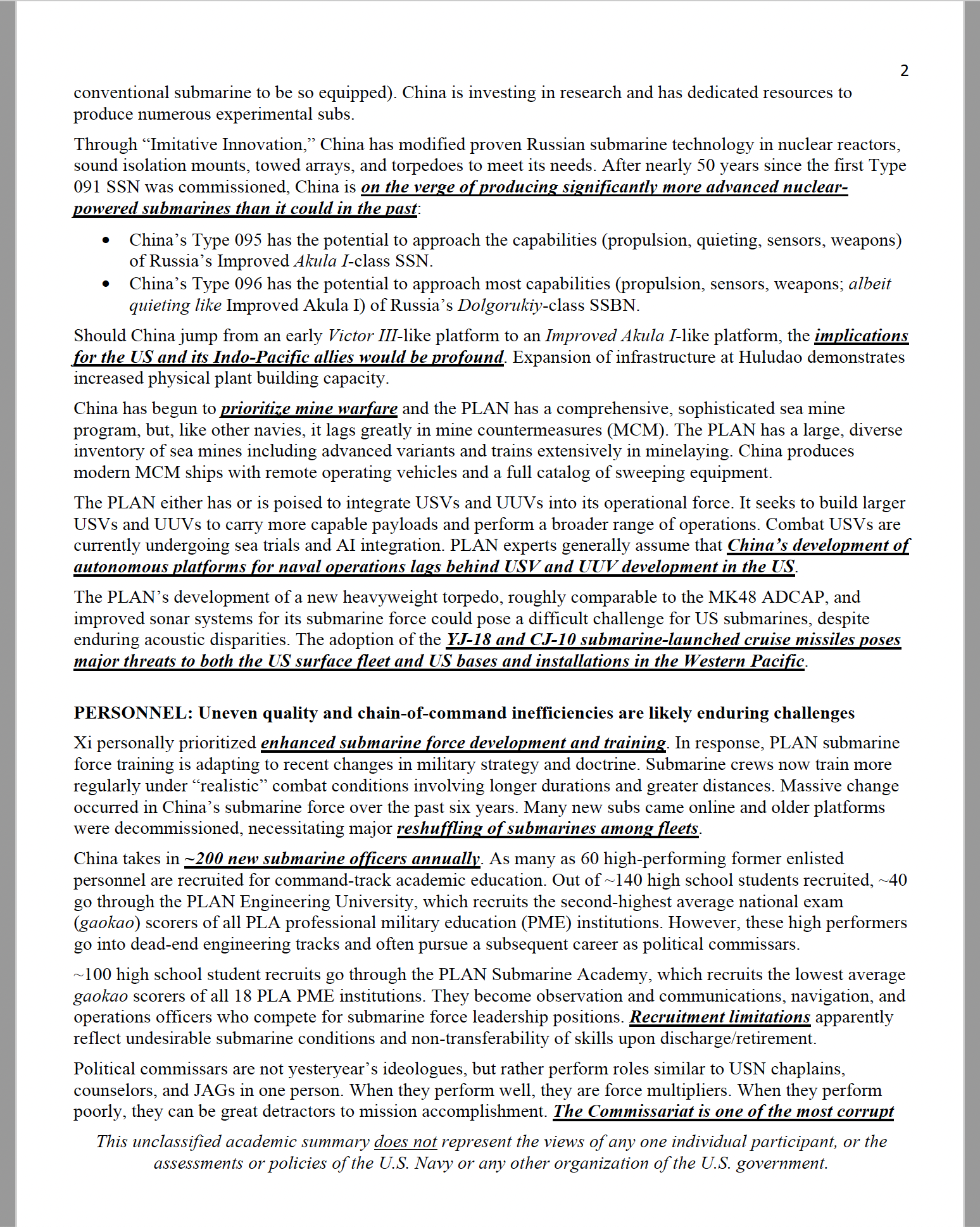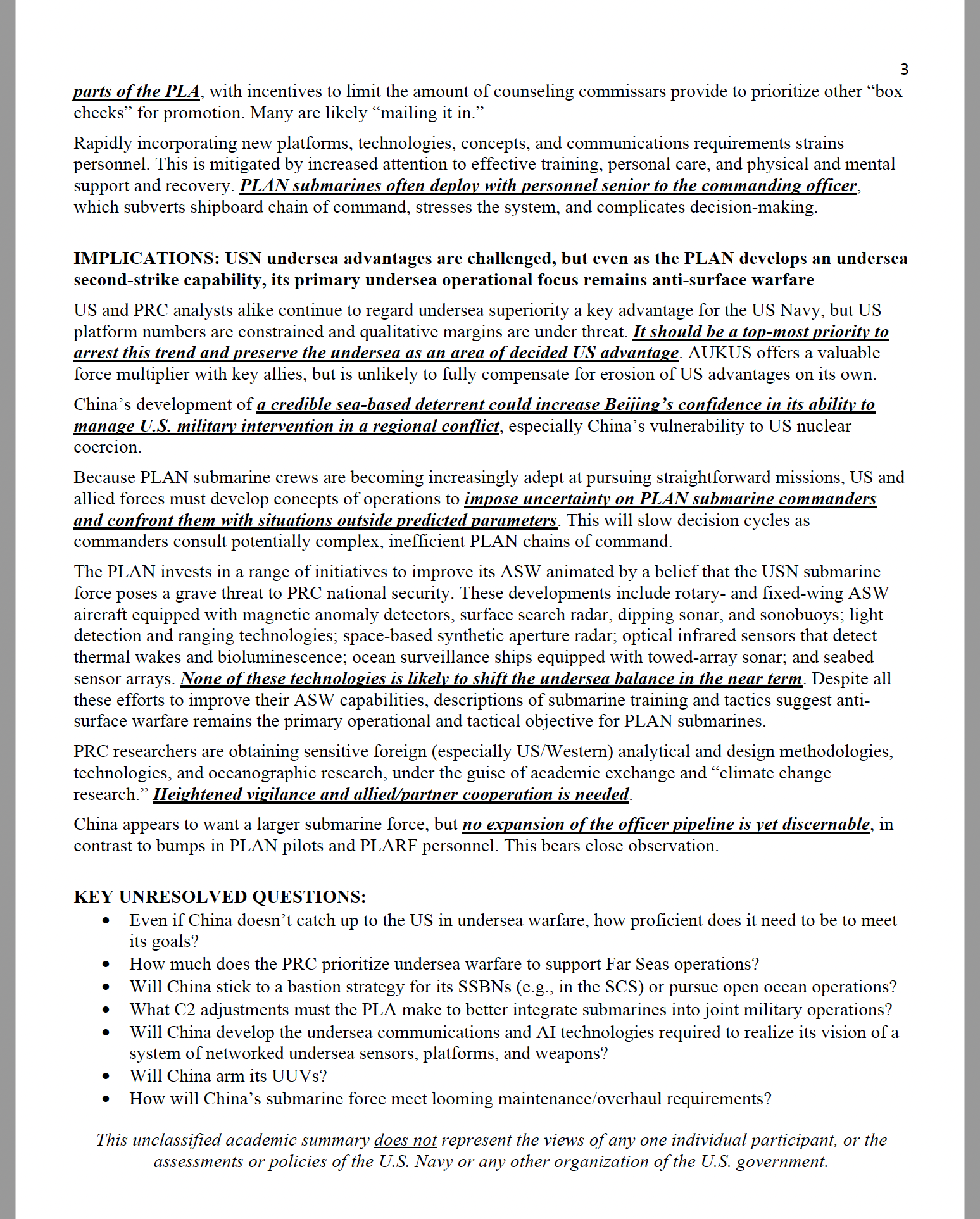Quick Look Summary—CMSI’s 11–13 April 2023 Conference: “Chinese Undersea Warfare: Development, Capabilities, Trends”
The Naval War College China Maritime Studies Institute (CMSI) has just released the Quick Look summary of its 11–13 April 2023 Conference on “Chinese Undersea Warfare: Development, Capabilities, Trends.”
***Please kindly note that this unclassified academic summary does not represent the views of any one individual participant, or the assessments or policies of the U.S. Navy or any other organization of the U.S. government.***
Click here to download a cached copy.
The People’s Republic of China is investing enormous energy and resources to improve its ability to fight in the undersea domain. What are the main lines of effort? To what extent are these efforts succeeding? What are the implications for the U.S. Navy and allied/partner navies? How can the U.S. Navy maintain its undersea advantage? This conference examined Chinese undersea warfare capabilities—present and future—in the context of intensifying great power competition with the United States. Topics covered included strategy and doctrine, submarine warfare, anti-submarine warfare, and seabed warfare. Drawing from original Chinese sources, panelists discussed Beijing’s pursuit of power in the undersea domain, with a focus on implications for U.S. national security.
China Maritime Studies Institute, “Chinese Undersea Warfare: Development, Capabilities, Trends,” Quick Look Conference Summary (Newport, RI: Naval War College, 5 May 2023).
QUICK LOOK REPORT
“CHINESE UNDERSEA WARFARE:
DEVELOPMENT, CAPABILITIES, TRENDS”
The China Maritime Studies Institute held an academic conference on the topic of the People’s Liberation Army Navy’s Undersea Warfare from 11–13 April 2023. The first two days involved unclassified presentations by scholars, government officials, and naval officers. Classified sessions were held on the third day and will be reported separately. The roughly 175 attendees were mostly US citizens, with several allied participants. Panel topics included 1) strategic and operational factors, 2) submarine force hardware, 3) submarine force human factors, 4) ASW, 5) seabed warfare, and 6) challenges and countermeasures for the U.S. Navy.
STRATEGIC & OPERATIONAL FACTORS: PRC strategists deem undersea warfare essential to countering USN strengths
Undersea warfare is a core component of PRC naval strategy. Within the First Island Chain, it is critical to achieving the PLAN’s aim of sea control in wartime. Beyond the First Island Chain and in the Indian Ocean, effective undersea operations are deemed necessary to counter USN domain superiority and to thwart third party intervention in an East Asian conflict. PRC leaders consider undersea warfare important for the long-term protection of China’s global interests, including in the Arctic.
PLAN discussions of “seabed warfare” (including defending, compromising, and attacking undersea cables) are centered on the “deep sea” as a realm of growing importance for military competition and conflict. Military-Civil Fusion is key to China’s approach to developing new technologies to help the PLAN seize the initiative in future deep-sea conflict.
In recent years, the PLAN has invested heavily to develop new capabilities to boost its awareness of—and ability to forecast—the undersea operating environment, but PLAN experts believe that their meteorology and oceanography capabilities significantly lag those of the USN. This comparative ignorance of the ocean battlespace environment is a major impediment to PLAN submarine and ASW operations, especially beyond the First Island Chain.
PLA doctrine views undersea warfare as best conducted through as an integrated “system of systems.” PRC analysts fear strong US and allied undersea capabilities, but the PLAN is determined to close the gap as much and as quickly as possible while pursuing superiority of its own in other areas (e.g., through joint operations with the PLARF).
HARDWARE: China has a large force of potent diesel submarines, and is on the verge of producing greatly improved nuclear-powered submarines
The Soviet Union denied technical support to China, which had to design and build nuclear-powered submarines on its own. China successfully produced functional submarines, but not effective ones. Since 1996 Russia has supplied considerable support.
In recent years, China has seen tremendous expansion in the shipbuilding facilities that can produce both conventional- and nuclear-powered submarines. Nevertheless, China’s technological progress in submarine construction has been uneven, with enduring weaknesses in propulsion and quieting. To compensate, China has exploited its partnership with Russia to obtain access to cutting-edge submarine-related technologies.
China operates the world’s largest fleet of air-independent-power submarines. An improved variant of the Yuan-class AIP submarine features a new, angled sail and an integral towed array sonar (the PLAN’s first conventional submarine to be so equipped). China is investing in research and has dedicated resources to produce numerous experimental subs.
Through “Imitative Innovation,” China has modified proven Russian submarine technology in nuclear reactors, sound isolation mounts, towed arrays, and torpedoes to meet its needs. After nearly 50 years since the first Type 091 SSN was commissioned, China is on the verge of producing significantly more advanced nuclear-powered submarines than it could in the past:
- China’s Type 095 has the potential to approach the capabilities (propulsion, quieting, sensors, weapons) of Russia’s Improved Akula I-class SSN.
- China’s Type 096 has the potential to approach most capabilities (propulsion, sensors, weapons; albeit quieting like Improved Akula I) of Russia’s Dolgorukiy-class SSBN.
Should China jump from an early Victor III-like platform to an Improved Akula I-like platform, the implications for the US and its Indo-Pacific allies would be profound. Expansion of infrastructure at Huludao demonstrates increased physical plant building capacity.
China has begun to prioritize mine warfare and the PLAN has a comprehensive, sophisticated sea mine program, but, like other navies, it lags greatly in mine countermeasures (MCM). The PLAN has a large, diverse inventory of sea mines including advanced variants and trains extensively in minelaying. China produces modern MCM ships with remote operating vehicles and a full catalog of sweeping equipment.
The PLAN either has or is poised to integrate USVs and UUVs into its operational force. It seeks to build larger USVs and UUVs to carry more capable payloads and perform a broader range of operations. Combat USVs are currently undergoing sea trials and AI integration. PLAN experts generally assume that China’s development of autonomous platforms for naval operations lags behind USV and UUV development in the US.
The PLAN’s development of a new heavyweight torpedo, roughly comparable to the MK48 ADCAP, and improved sonar systems for its submarine force could pose a difficult challenge for US submarines, despite enduring acoustic disparities. The adoption of the YJ-18 and CJ-10 submarine-launched cruise missiles poses major threats to both the US surface fleet and US bases and installations in the Western Pacific.
PERSONNEL: Uneven quality and chain-of-command inefficiencies are likely enduring challenges
Xi personally prioritized enhanced submarine force development and training. In response, PLAN submarine force training is adapting to recent changes in military strategy and doctrine. Submarine crews now train more regularly under “realistic” combat conditions involving longer durations and greater distances. Massive change occurred in China’s submarine force over the past six years. Many new subs came online and older platforms were decommissioned, necessitating major reshuffling of submarines among fleets.
China takes in ~200 new submarine officers annually. As many as 60 high-performing former enlisted personnel are recruited for command-track academic education. Out of ~140 high school students recruited, ~40 go through the PLAN Engineering University, which recruits the second-highest average national exam (gaokao) scorers of all PLA professional military education (PME) institutions. However, these high performers go into dead-end engineering tracks and often pursue a subsequent career as political commissars.
~100 high school student recruits go through the PLAN Submarine Academy, which recruits the lowest average gaokao scorers of all 18 PLA PME institutions. They become observation and communications, navigation, and operations officers who compete for submarine force leadership positions. Recruitment limitations apparently reflect undesirable submarine conditions and non-transferability of skills upon discharge/retirement.
Political commissars are not yesteryear’s ideologues, but rather perform roles similar to USN chaplains, counselors, and JAGs in one person. When they perform well, they are force multipliers. When they perform poorly, they can be great detractors to mission accomplishment. The Commissariat is one of the most corrupt parts of the PLA, with incentives to limit the amount of counseling commissars provide to prioritize other “box checks” for promotion. Many are likely “mailing it in.”
Rapidly incorporating new platforms, technologies, concepts, and communications requirements strains personnel. This is mitigated by increased attention to effective training, personal care, and physical and mental support and recovery. PLAN submarines often deploy with personnel senior to the commanding officer, which subverts shipboard chain of command, stresses the system, and complicates decision-making.
IMPLICATIONS: USN undersea advantages are challenged, but even as the PLAN develops an undersea second-strike capability, its primary undersea operational focus remains anti-surface warfare
US and PRC analysts alike continue to regard undersea superiority a key advantage for the US Navy, but US platform numbers are constrained and qualitative margins are under threat. It should be a top-most priority to arrest this trend and preserve the undersea as an area of decided US advantage. AUKUS offers a valuable force multiplier with key allies, but is unlikely to fully compensate for erosion of US advantages on its own.
China’s development of a credible sea-based deterrent could increase Beijing’s confidence in its ability to manage U.S. military intervention in a regional conflict, especially China’s vulnerability to US nuclear coercion.
Because PLAN submarine crews are becoming increasingly adept at pursuing straightforward missions, US and allied forces must develop concepts of operations to impose uncertainty on PLAN submarine commanders and confront them with situations outside predicted parameters. This will slow decision cycles as commanders consult potentially complex, inefficient PLAN chains of command.
The PLAN invests in a range of initiatives to improve its ASW animated by a belief that the USN submarine force poses a grave threat to PRC national security. These developments include rotary- and fixed-wing ASW aircraft equipped with magnetic anomaly detectors, surface search radar, dipping sonar, and sonobuoys; light detection and ranging technologies; space-based synthetic aperture radar; optical infrared sensors that detect thermal wakes and bioluminescence; ocean surveillance ships equipped with towed-array sonar; and seabed sensor arrays. None of these technologies is likely to shift the undersea balance in the near term. Despite all these efforts to improve their ASW capabilities, descriptions of submarine training and tactics suggest anti-surface warfare remains the primary operational and tactical objective for PLAN submarines.
PRC researchers are obtaining sensitive foreign (especially US/Western) analytical and design methodologies, technologies, and oceanographic research, under the guise of academic exchange and “climate change research.” Heightened vigilance and allied/partner cooperation is needed.
China appears to want a larger submarine force, but no expansion of the officer pipeline is yet discernable, in contrast to bumps in PLAN pilots and PLARF personnel. This bears close observation.
KEY UNRESOLVED QUESTIONS:
- Even if China doesn’t catch up to the US in undersea warfare, how proficient does it need to be to meet its goals?
- How much does the PRC prioritize undersea warfare to support Far Seas operations?
- Will China stick to a bastion strategy for its SSBNs (e.g., in the SCS) or pursue open ocean operations?
- What C2 adjustments must the PLA make to better integrate submarines into joint military operations?
- Will China develop the undersea communications and AI technologies required to realize its vision of a system of networked undersea sensors, platforms, and weapons?
- Will China arm its UUVs?
- How will China’s submarine force meet looming maintenance/overhaul requirements?








































